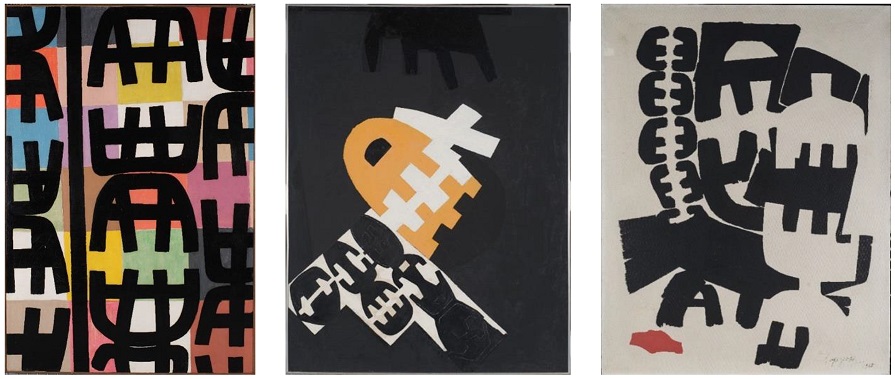The article presents the results of a diagnostic campaign carried out by several Institutes among which CNR ISPC, on three of Giuseppe Capogrossi’s abstract paintings from the 1950s and 1960s, conserved at the National Gallery of Modern and Contemporary Art in Rome. Non-invasive investigations by reflection FT-IR spectroscopy were carried out, followed by micro-destructive laboratory analyses using Py-GC-MS, and HPLC-ESI-Q-ToF. The investigations focused on identifying the binders used for both the preparation and the pictorial layers. In two of the paintings investigated, an industrial preparation was identified based on egg yolk, mixed with other organic materials (acryl resin, oil, animal glue). The paint media include the use of both oil and alkyd paint. In one of the three paintings, the presence of a styrene-acryl resin was observed. The results show the simultaneous use of traditional and innovative materials, confirming the complexity of the period in which the artist was active, characterized by the technical experimentation of both the artists and manufacturers. The research also contributes to a better understanding of Giuseppe Capogrossi’s artistic profile, from the point of view of executive techniques.
Categorie
- Call (15)
- Call for abstracts (5)
- Call for access (1)
- Call for papers (9)
- call TNA (3)
- Conferences (17)
- conferenza online (3)
- Dottorato di ricerca (4)
- Events (32)
- Focus (21)
- Job opportunities (6)
- News (144)
- Non categorizzato (2)
- Science news (3)
- science stories (2)
- simposio (2)
- Training camp (1)
- virtual meeting (2)
- webinar (6)
- workshop (5)
Articoli recenti
- Call for Access to E-RIHS ERIC Services | Deadline for submission: September 30, 2025 Luglio 1, 2025
- Fourth and Final H2IOSC TNA/NA Call Now Open Giugno 16, 2025
- ECHOES Consultation: help shape the future of the European Collaborative Cloud for Cultural Heritage | Open until the end of June 2025 Giugno 10, 2025
- GRAPHIA Launches its First Webinar: “Introduction to Knowledge Graphs” Maggio 23, 2025
- Open position at the University of Barcelona as a Lecturer of Organic Chemistry applied to Cultural Heritage| Deadline: May 29, 2025 Maggio 21, 2025
- Fondazione Opificio Opens Registrations for Short Courses in Heritage Conservation and Risk Preparedness Maggio 19, 2025

